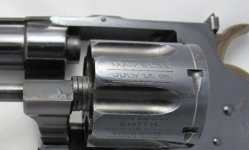The ATF's rules are written to deal with all firearms, not just S&Ws. Some years ago Roy Jinks sent letters to the ATF to certify that Model 1896s & NM#3 DAs frames were all made before the 1898 cutoff date used by the ATF. Notwithstanding comments above, S&W frames were made by drop forging steel billets and the serial numbers were added to the frames as they were polished to size. The pay system was by piece rate, so a method of counting gun manufactured was required in order to pay the Floor Foremen, who inturn then paid their crews. The Foremen kept daily records in a Day Book, by date and serial number and model of gun manufactured by their crews. S&W factory does not have these Day Books, they are either missing or in the hands of a few collectors. Roy Jinks does not have easy access to them to include the manufacture date and the shipping dates in factory letters, he only has the shipping records, and the ATF relies on those to calculate dates for determination of Antique, C&R, or FFL needs, except for the models that Roy has certified that the frames were made earlier than Dec 31,1898 . Ship dates are the evidence used in Courts as evidence of whether a gun is an antique, or not, as in most cases that's the evidence submitted by the ATF, however should a case depend entirely on a ship date is the compelling evidence, and the manufacture date from a S&W Floor Foremen's Day Book was entered as preceding a ship date, the Day Book entry would trump the ship date. That would have to be provided by testimony of an Expert Witness, providing the Day Book as evidence and certifying thereto. As a side issue, an FFL holder who insists they paper an antique, for a fee, has no defense to a letter to the ATF alleging fraud for monetary reward, and it could get them a black mark for their next audit. Ed.


